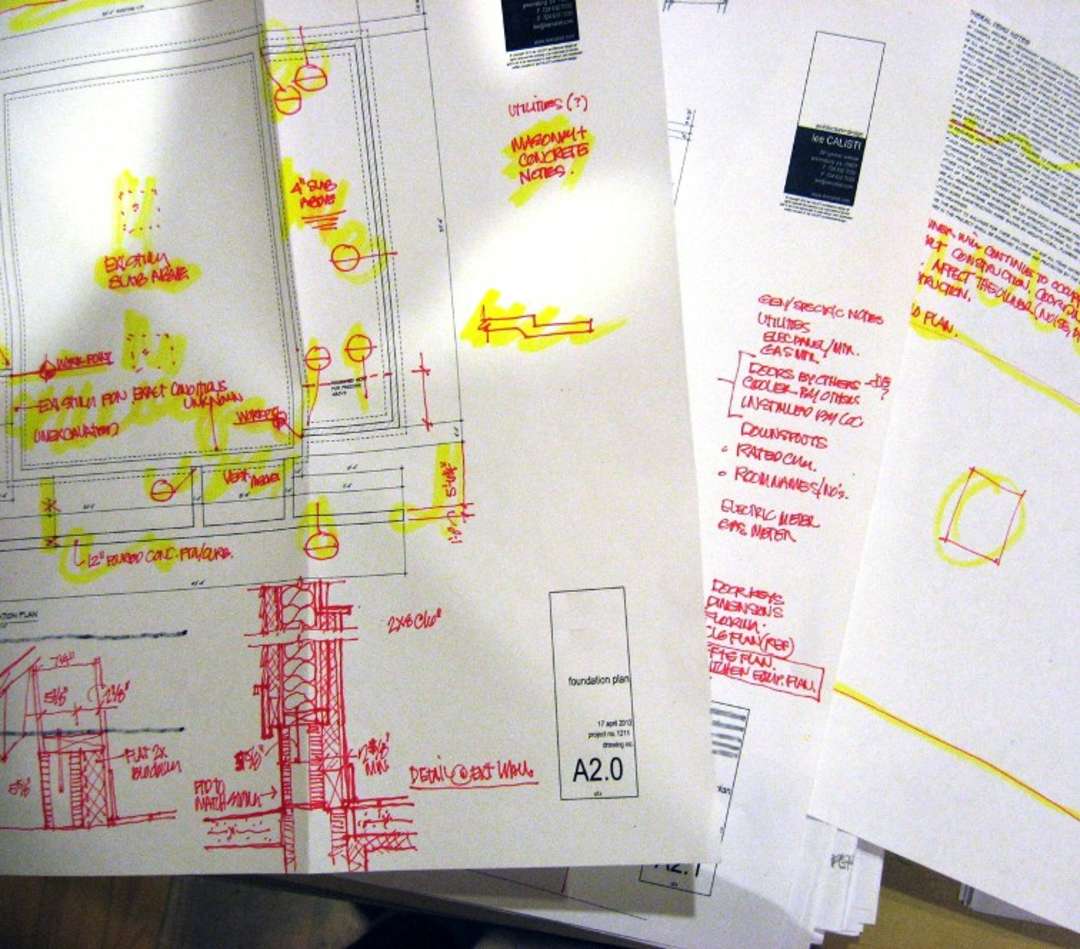
What Are Redlines?
Redlines are architectural drawings that have been printed, reviewed and marked up with errors, changes and revisions. The markups are typically done in red ink to make them easier to find, hence the name Redlines.
As a set of construction drawings moves from a schematic design into the creation of construction drawings that a builder will use, printing out the drawings at 50 percent (usually on 11 by 17 sheets of paper) and full size (24 by 36 sheets or larger) is necessary to ensure quality control.
When drawing in CAD, the line weights (thicknesses of the lines), shading, patterns and other elements are usually color coded. The thickness of a line shown on a computer is often very different than the reality of a printed line. There is also a level of translation between each printer. The gray shading on one printer will usually be very different than the gray shading on another printer. So frequently printing PDF files on paper to do quality control makes excellent sense.
I personally print out as much as I need to, and sometimes that’s a lot. By printing so much, it actually allows me to work faster and be much more thorough, ensuring that a potential error is not made. The cost of the paper is always much cheaper and significantly more sustainable than dealing with an error on a construction site.
Everyone has different preferences, but when I work on a set of construction drawings, I love to mark up my own work on printed-out sets. It’s nice to back away from the computer screen and see the work on paper as it starts to move closer to what the contractor will need to build it. Some people use various kinds of software and draw all over PDF files in red and hardly ever print. No matter how you do it, you’re still arriving at a drawing with markups in red.
“Picking Up Redlines … ”
… Is a term used when someone marks up a set of drawings with all the errors, changes and revisions in red ink. Then they explain all the changes that need to be made on the drawings to another person (who typically has a lower pay rate, let’s be honest), and that person will go into the drafting software to make all the changes.
Picking up redlines is a fantastic way for junior staff to really tap into the knowledge, experience and expertise of more-senior-level members in the firm. Honestly, being the drafter for other, more experienced architects was one of the most important parts of my education. It taught me a lot about their decision-making process, which is great stuff for someone beginning their career. A ton of learning takes place picking up redlines.
Creating Construction Drawings Is an Art.
Putting together a clear, concise and thorough set of construction documents for a contractor to build from is a skill and an art form. Anyone who does this work has their own systems, theories and philosophies about how to put together a set of drawings.
The real power of picking up redlines is doing this job with many different people and tapping into the collective knowledge of the office. Everyone at the office has different experience and a different area of expertise. A good attitude to have is: Know there is valuable knowledge you can learn from every single person at the office and be open to learning something from everyone.
Highlighting completed redline drawing amendments helps you keep track; image via Think Architect.
Don’t Get Lost!
When picking up redlines it’s really easy to forget the changes that you have made as you move through the markups, especially if you do not complete all the redlines in one sitting. The very best way to keep track of the work that has been done is to use a highlighter and mark off each redline mark that has been picked up or completed.
Redline your own drawings before you ask someone else to.
There are two important concepts you need to understand if you are spending many hours drafting:
1. The drawings will never be perfect. You can work on a set of drawings for 143,567 hours, and there will always be more you can add.
2. When you are working on a drawing and putting a lot of thought and energy into it, you can become very blind to a blatantly obvious error. You just don’t see it because you have been staring at the same drawing for too long.
A classic redline drawing; image via Alembic Studio
When I first started working in offices, I used to work really hard on drawings, print them and then hand them right to my supervisor without reviewing them first. He would find the most obvious errors that I couldn’t see on the screen but were blatant once they were printed. For a long time, I used to feel really sheepish because my drawings had sloppy errors on them.
At some point, I got sick of this stupid concept being a distraction and making me repeatedly look like a fool. So I started to get very obsessive about making it a habit to always check my own drawings before I handed them to my boss to review. By doing this, it showed that I took the time to review my own work, and I felt better about catching that spelling mistake before the boss did.
Every Boss will be appreciative of seeing your layer of redlines before they add theirs.
Want More?
If you’re interested in reading more Young Architect Articles written specifically for Architecture Students, please visit this dedicated section of the site.


